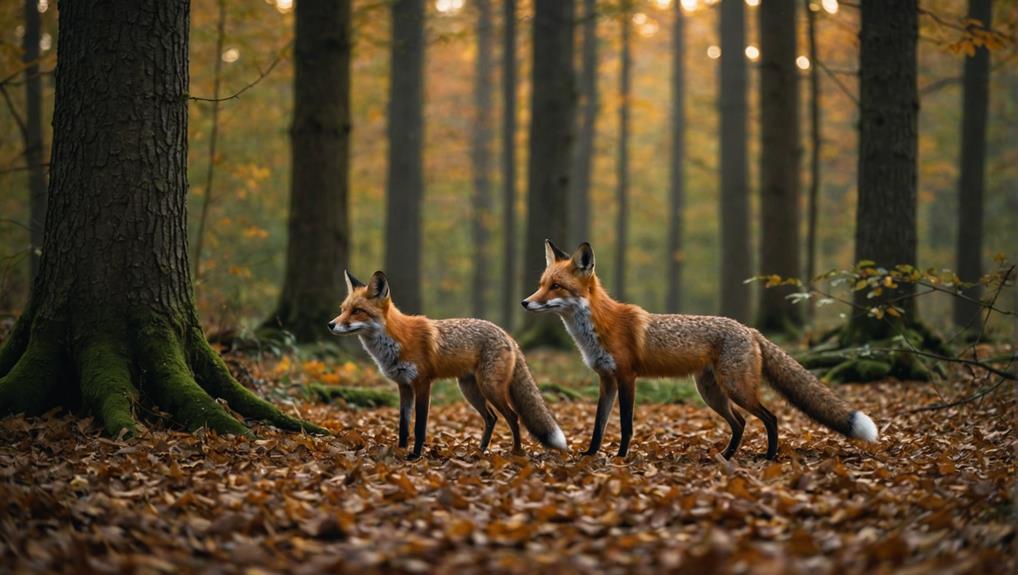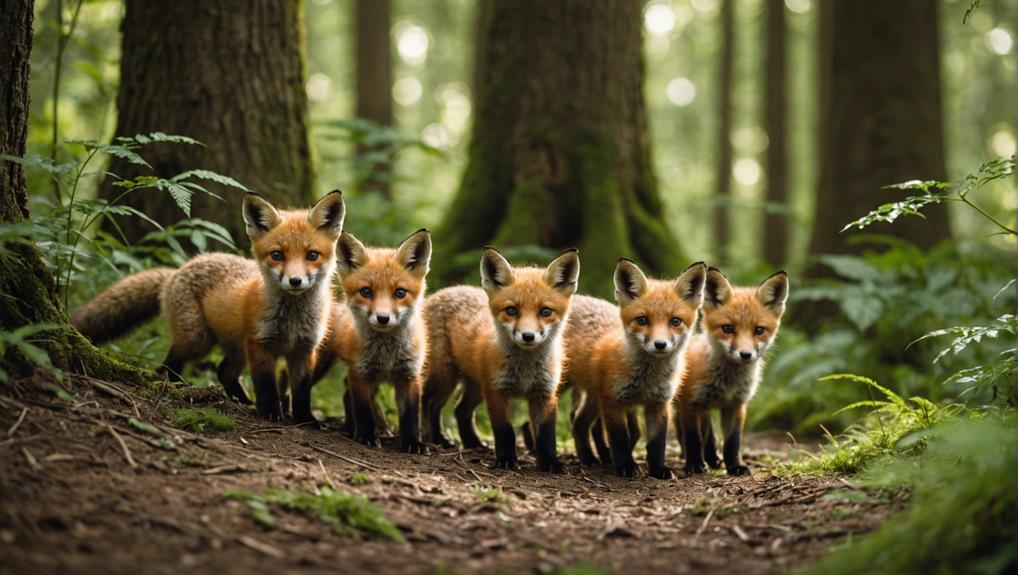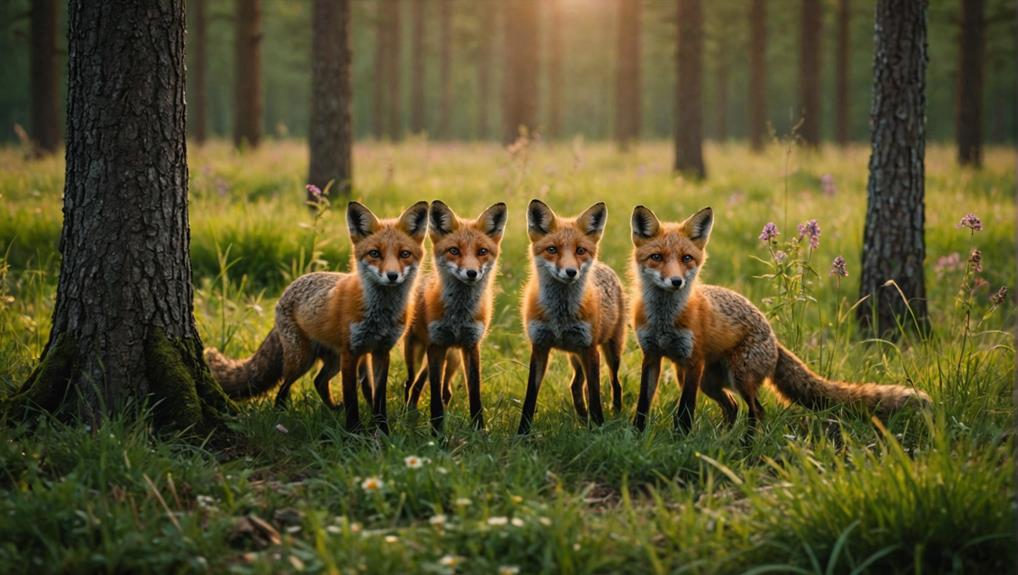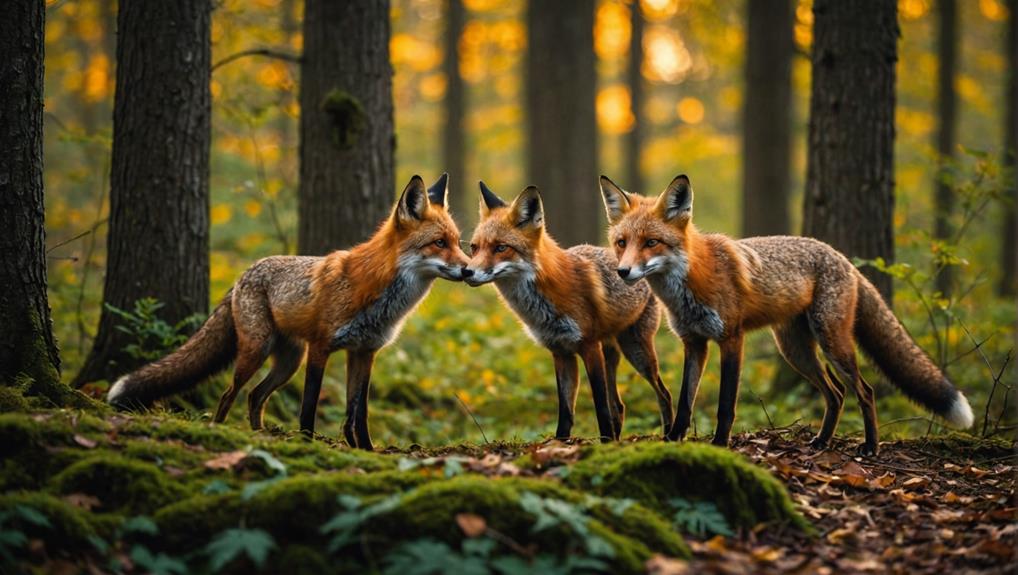Fox mating season kicks off from late December and runs through late March, hitting its peak in January and February. During this time, vixens and their suitors get busy with playful courtship, expressive vocalizations, and picking cozy dens for their future cubs. After a gestation of about 51 to 54 days, the adorable little furballs, typically 4 to 8 in a litter, make their grand entrance, blind and full of dark fur. Isn't that cute? As these tiny pups grow, they'll learn all the tricks of the trade from their devoted parents. Stick around, and you'll discover even more fascinating details!
Contents
Overview of Fox Mating Season
Fox mating season spans a critical period from late December to late March, with January and February being the most active months. During this time, you might hear the charming sounds of foxes communicating. Their courtship includes a variety of vocalizations, like barking and those wild screams that can make you double-check the windows!
As the breeding season unfolds, the vixen, or female fox, takes on the important task of selecting a cozy den for her future little ones. These dens can be burrows or remodeled spaces from past residents—quite the real estate savvy move!
The gestation period is around 51 to 54 days, and after this waiting game, she usually welcomes an average litter of four to five cubs.
It's fascinating to note that foxes reach sexual maturity by about 10 months. However, younger foxes may wait until they're a bit older to join in on the fun, leading to a limited breeding season for some females.
Breeding Cycle Details
During the breeding cycle, vixens become particularly selective about their den locations, seeking out safe and sheltered spots to give birth to their young. The fox mating season kicks off from late December to late March, with most action happening in January and February.
It's a busy time for these clever canines, as they prepare for the arrival of their pups. Particularly, different fox species, such as the Red fox, exhibit unique reproductive behaviors and adaptations based on their environments.
Once a vixen finds the perfect den, she'll settle in for the gestation period, which lasts about 51 to 54 days. By the end of this time, she usually welcomes a litter of 4 to 8 pups. Imagine those tiny bundles of joy, born blind and covered in dark chocolate-brown fur! They're like little surprises waiting to see the world.
Their eyes open around 10 to 14 days after birth, and they start to explore their surroundings. After about 4 to 5 weeks, these curious cubs begin to emerge from the den, gradually turning a lovely red-brown as they grow.
It's a heartwarming sight, watching them learn and play together. So, if you're ever out in the wild during this season, keep an eye out for these adorable little pups! They'll surely bring a smile to your face.
Courtship Behaviors

As you watch the foxes during mating season, you'll notice their lively courtship behaviors, which are quite the spectacle!
They vocalize with a mix of barks and howls, clearly establishing their bond and territory.
Plus, you'll see playful chases and scent marking, all part of their unique way of forming a strong pair bond that often lasts well beyond the breeding season.
Vocalizations During Courtship
Engaging in vocalizations during courtship, foxes create a dynamic symphony that enhances their mating rituals. During the mating season, which runs from late December to late March, you'll hear an array of sounds echoing through the woods.
Imagine this: a male fox, or dog fox, belts out loud barks and screams, trying to grab the attention of a female while also warding off rival males. It's quite the performance!
On the flip side, the female fox, known as a vixen, responds with softer sounds that signal her receptiveness. It's like a duet, where each vocalization strengthens their pair bonds and helps them coordinate during this exciting time.
These sounds aren't just noise; they're essential for communication between mates, allowing them to connect and navigate their environment together.
Den Site Selection
Selecting the right den site is essential for a female vixen during the courtship phase. After all, this cozy nook is where she'll raise her adorable pups, and safety is key! Vixens often look for den sites in tree roots, crevices, or even piles of discarded debris.
This behavior aligns with their natural instincts to find secure locations that provide protection from predators and harsh weather conditions, which is fundamental for ensuring the survival of their young. It's pretty clever, don't you think? They know that a secure location helps protect their little ones from potential dangers.
Once the vixen has chosen her perfect spot, she'll settle in for a gestation period of about 51 to 54 days. That's a lot of waiting! After that, she usually gives birth to a litter of four to five cubs—talk about a busy household!
Vixens often reuse or remodel dens from previous occupants, showing just how important it's to pick the right place for pup rearing. In fact, the choice of den site can considerably influence the survival rates of the cubs, reflecting the essential role of habitat variety in their development diverse ecosystems.
Pair Bond Formation
During the breeding season, foxes form strong pair bonds that are vital for their reproductive success. This special time usually spans from late December to late March, with the most action happening in January and February.
You might be surprised to learn that courtship behaviors are quite lively! Male and female foxes make a variety of vocalizations, like barking and unique screams, to attract each other, showcasing their unique adaptations for survival in different environments. It's like their own little love language!
As they get to know one another, these foxes engage in heartwarming mutual grooming and playful antics. This isn't just fun; it's essential for pair bond formation. By building this connection, they lay the groundwork for teamwork when it comes to raising their pups.
The male often becomes a dedicated provider, bringing food for the pregnant vixen. Isn't that sweet?
Interestingly, even non-breeding yearling foxes join in the fun, helping out with the pups. This shows how social and cooperative behaviors flourish during the mating season.
Gestation and Birth
Typically, the fox mating season runs from late December to late March, with most pairs mating in January and February. After this romantic whirlwind, the female fox, known as the vixen, enters a gestation period lasting about 51 to 54 days. Can you imagine waiting that long for a family? It's a delightful anticipation!
When the time finally arrives, the vixen gives birth to a litter of about 4 to 6 adorable pups. These little ones are born blind and covered in dark chocolate-brown fur, weighing around 96 grams, or about 3.4 ounces. They're tiny bundles of joy!
For the first two weeks, the vixen stays close to her pups, nurturing them while the male, or dog fox, gathers food. It's a team effort, showcasing the beauty of family and support.
As the pups grow, they begin to emerge from their cozy den around 4 to 5 weeks old. At this stage, their fur starts to change to that charming red-brown we all adore. Watching this transformation is like witnessing a little miracle unfold right before your eyes!
Cub Development Stages

In the fascinating journey of a red fox cub's development, you'll witness remarkable changes in just a few short weeks. When foxes give birth, the cubs arrive blind and covered in dark chocolate-brown fur, looking more like little wriggly sausages than adorable foxes!
By 10 to 14 days, their eyes begin to open, revealing those bright little peepers that will soon explore the world.
Around 4 to 5 weeks, those cubs start to shift to a beautiful red-brown fur, and they're ready to venture out of the den. As urban foxes adapt to city life, you might catch a glimpse of these playful cubs exploring their surroundings.
By 28 to 35 days old, they become curious explorers, darting around the den and testing their tiny paws.
You'll notice they're weaned by 12 weeks, which means they're ready for family foraging trips. It's a wild adventure where they learn to hunt and gather, just like their parents!
Watching these cub development stages unfold is both heartwarming and a little hilarious, as those clumsy cubs learn the ropes of life in the wild—and sometimes, they trip over their own paws!
Parental Care Responsibilities
When it comes to parental care, red foxes showcase a remarkable teamwork dynamic that guarantees the survival of their young. The male fox takes on significant parental duties, ensuring the vixen and their cubs are well-fed, especially in those early weeks when the vixen can't leave the den.
Imagine that—a dedicated dad bringing home the bacon, or, in this case, the small critters!
Meanwhile, the vixen stays close to the pups for at least two weeks after birth, relying on her partner to provide food. It's a true partnership! Even non-breeding yearlings often pitch in, helping to teach the little ones important survival skills.
By around 4-5 weeks, the curious cubs start to explore outside the den, and both parents guide them in foraging and hunting.
This shared responsibility is essential, with both parents actively involved until the young are weaned at about 12 weeks old.
After that, the young foxes join the adults on foraging trips, stepping into the world with their parents' loving support.
Dispersal of Young Foxes

As young foxes reach maturity, they typically pack their bags and leave home around October and November, ready to find their own way in the world.
This big move is vital for them to claim their own territories, but it's not all fun and games—survival can be tough, with dangers lurking around every corner.
Timing of Dispersal
The timing of dispersal for young foxes is crucial for their survival and future reproduction. Typically, these adventurous little creatures leave their parental territory around October and November, right when they hit that magical age of 6 to 8 months.
Once they reach sexual maturity, they're not just looking for a new home; they're on a mission to find their own territories and potential mates.
You might find it fascinating that male foxes often roam farther than females in search of these new spaces.
But here's the kicker: about 55% of foxes don't make it past their first year. Dangers like vehicles, dogs, and even starvation can pose serious threats during this critical dispersal phase.
That said, successful dispersal is crucial! It helps prevent inbreeding, ensuring a healthier, more diverse population of foxes.
Plus, it allows them to discover new food resources, which is always a bonus.
Survival Challenges Faced
Maneuvering the world after leaving their parental territory, young foxes face a myriad of survival challenges that can make their quest for independence intimidating. Imagine stepping out into the big, wide world without a map!
These young foxes usually venture off in October and November, but their journey isn't just about finding a new home. It's often filled with danger. Many encounter vehicles, hungry dogs, or even the threat of starvation as harsh winter conditions settle in.
It's a tough reality, as about 55% of foxes don't make it through their first year. Yikes! That's a high mortality rate for these spirited little creatures. Yet, this natural dispersal is essential for ensuring genetic diversity and a healthy population. Each young fox must travel significant distances to secure their own territory.
While they're out there, they need to find food and a safe place to thrive. It's a rollercoaster ride of challenges, but every leap of faith they take brings them closer to establishing a home of their own.
Territory Establishment Process
Venturing out on their own, young foxes commence on a significant journey to establish their territories. This adventurous phase typically kicks off in October and November, when they seek independence. As they roam, young males often cover greater distances than their female counterparts, sometimes exceeding 400 km (248 miles). Talk about a road trip!
Establishing a territory is essential. It's not just about finding a cozy den; it's about ensuring access to food and a safe environment. Sadly, about 55% of young foxes face dangers from vehicles, dogs, and even hunger during their first year. These challenges can impact their life expectancy, making successful territory establishment even more significant.
When young foxes stake their claim, they enhance their chances of survival and reproduction, leading to a healthier gene pool.
Impact of Environmental Factors
Environmental factors play an essential role in the fox mating season, influencing everything from breeding success to pup survival. You mightn't realize it, but temperature and daylight length can actually dictate when these clever critters decide to mate. Typically, the season runs from late December to late March, peaking in January and February.
Food availability and stable habitats are crucial for their breeding success. If the food's scarce or the weather's wild, you can bet the foxes will struggle to find the right conditions for raising their young. They need dens that shield their pups from harsh rain and wind, which means weather patterns can make all the difference.
You may notice that fox populations can vary in mating success based on where they live. This can lead to changes in litter size and how well those adorable little pups thrive.
Plus, extreme weather events like heavy snow or drought can throw a wrench into the timing of their reproduction, affecting population dynamics overall.
Frequently Asked Questions
What Time of Year Are Foxes Most Active?
During spring and summer, you'll notice increased fox activity. Their behavior shifts with seasonal rhythms, as they adapt to daylight foraging while still maintaining nocturnal activity, especially in urban areas where human encounters are minimized.
Why Do Female Foxes Scream During Mating?
When you observe female foxes screaming, you're witnessing essential vocalizations. These sounds enhance mating behavior and facilitate reproductive communication, signaling readiness to potential partners while establishing territory and minimizing competition during the breeding season.
What Month Do Foxes Have Babies?
In late March to early May, you'll witness fox reproduction as pups are born. During this time, observe their denning behavior and watch for cub development as they grow and explore their new environment.
What Happens When a Female Fox Is in Heat?
When a female fox is in heat, you'll notice her increased vocalizations and distinctive mating rituals. These reproductive signs help attract males, leading to competition, but she typically chooses one partner for mating.
Final Thoughts
In the wild world of foxes, mating season is a fascinating time! Did you know that a female fox can have up to six cubs in one litter? That's a lot of little paws running around! These adorable cubs grow quickly, learning the ropes of survival. As they venture out into the world, it's heartwarming to see them thrive. So, whether you're watching from afar or just curious, remember that nature's rhythm is full of surprises and joy!














